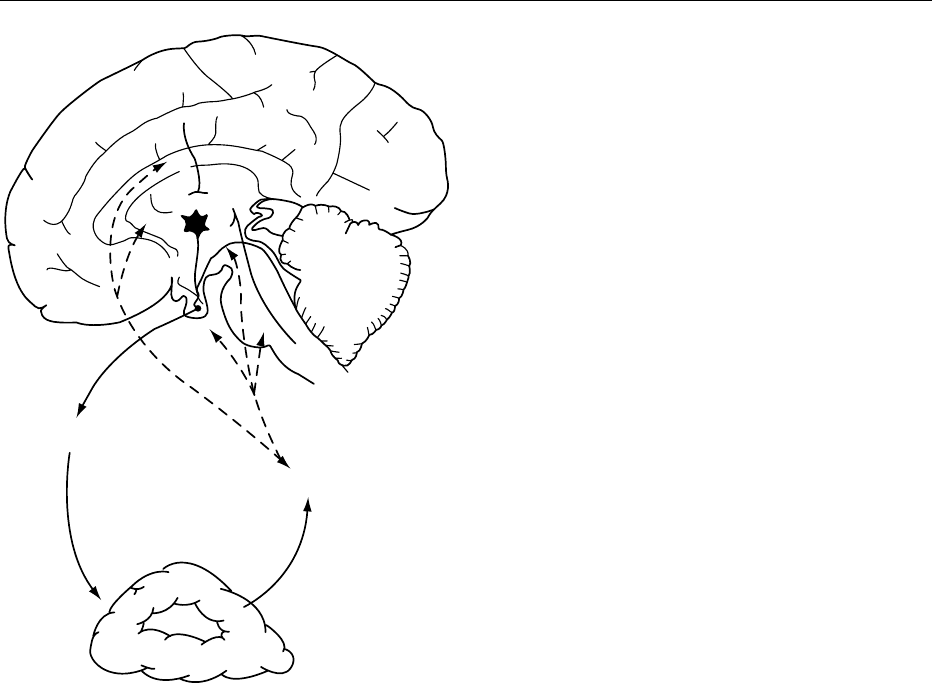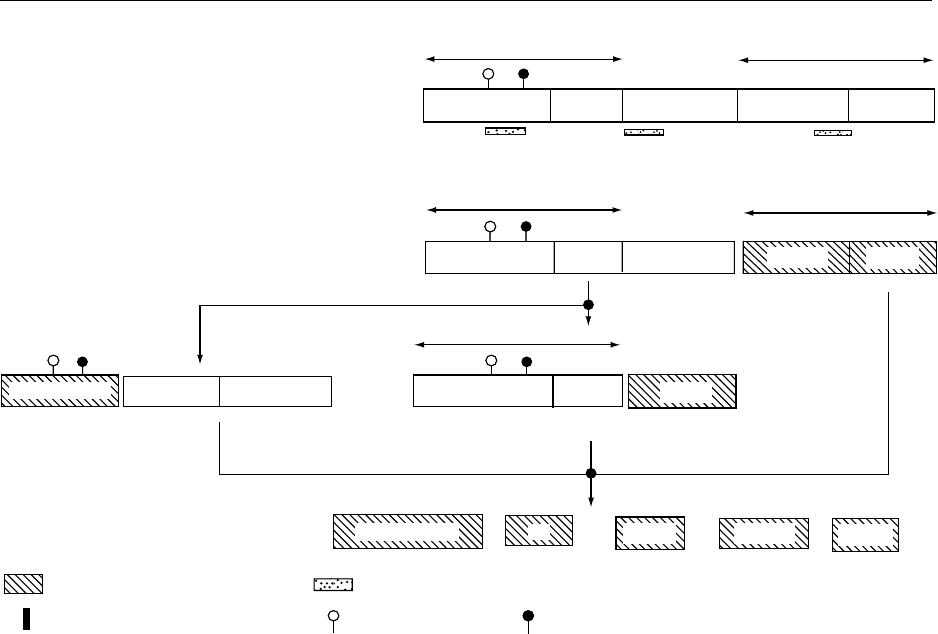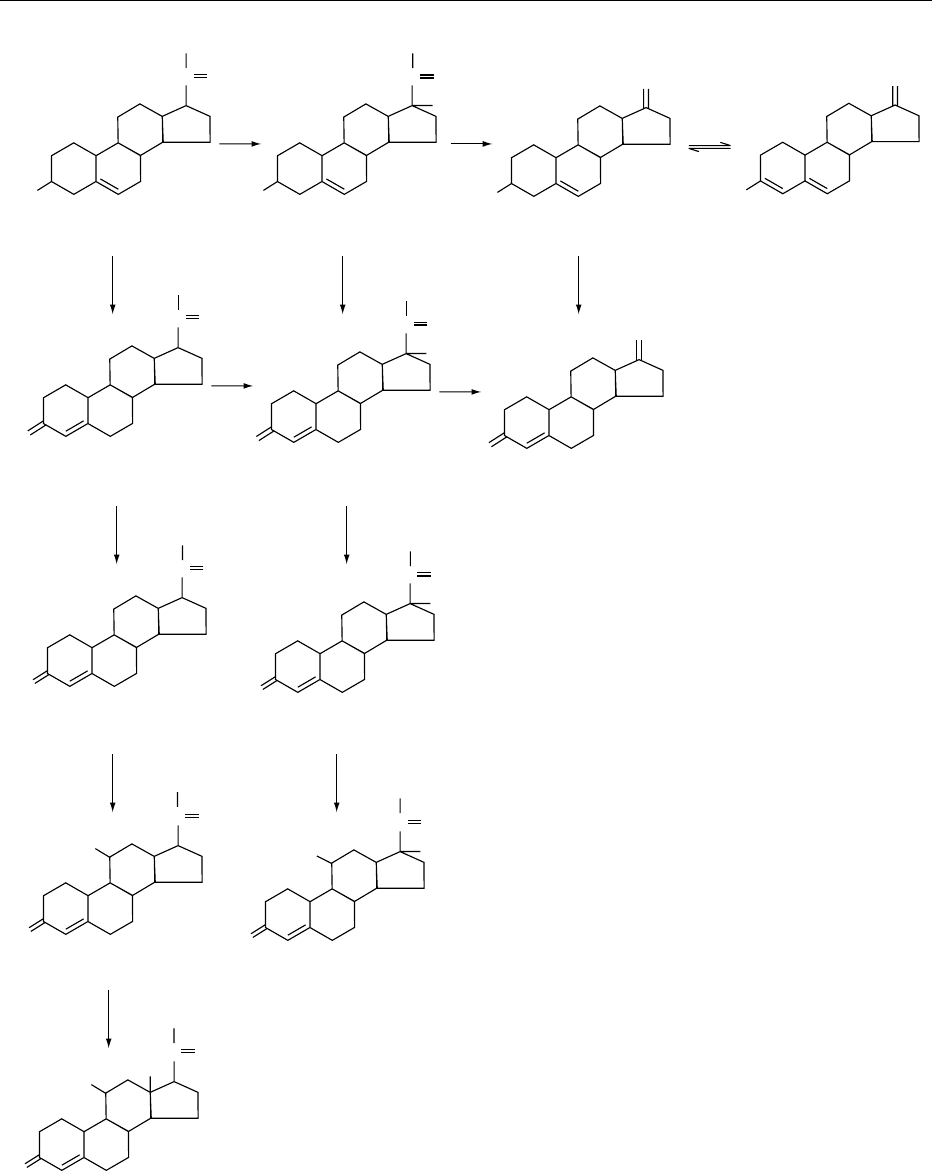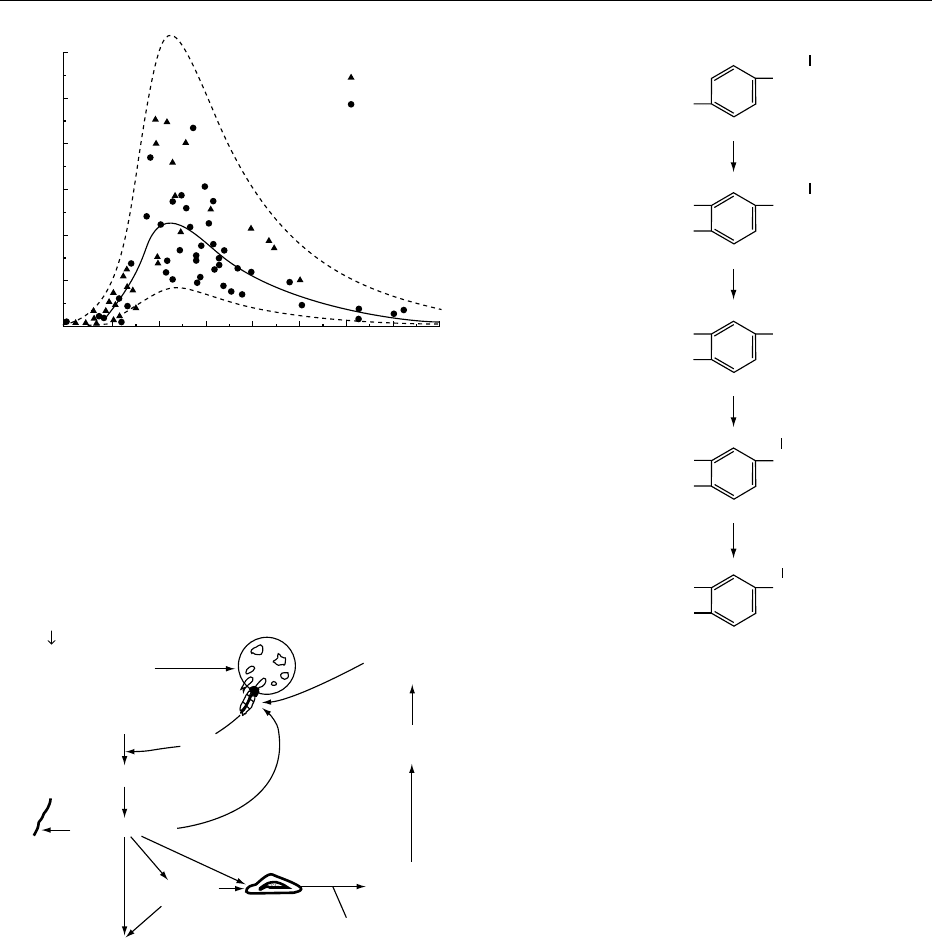Caballero B. (ed.) Encyclopaedia of Food Science, Food Technology and Nutrition. Ten-Volume Set
Подождите немного. Документ загружается.


for about 0.5% of the solids. The acids account for
the low average pH (3.99) value, which is in part
responsible for the excellent stability of honey.
Several acids have been found in honey, gluconic
acid being present in considerable excess over the
others. It arises from glucose through the action of
the enzyme glucose oxidase, added by the honeybee.
The combined effect of its acidity and the hydrogen
peroxide concurrently produced assist in preserving
nectar and honey from spoilage. Less prominent acids
reported to be in honey are formic, acetic, butyric,
lactic, oxalic, succinic, tartaric, maleic, pyruvic, pyr-
oglutamic, a-ketoglutaric, glycollic, citric, malic, 2-
or 3-phosphoglyceric acids, and glucose 6-phosphate.
(See Acids: Properties and Determination.)
Proteins and Amino Acids
0021 Protein and amino acid levels in honey are reflected in
nitrogen content, which is low, 0.04% on the average,
but variable, ranging up to 0.1%. About 40–80% of
the total nitrogen in honey is in protein, and most
of the remainder resides in the free amino acids.
About 20 different nonenzymatic proteins have been
identified in honey, many of which are common to all
honeys. Some appear to originate in the honeybee,
and others in the plant source of nectar. Except for
the honey enzymes, little is known about many of the
proteins in honey. Their presence results in honeys
having a lower surface tension than they would have
otherwise, and this encourages the formation of fine
air bubbles and a marked tendency to foam. (See
Protein: Food Sources.)
0022 The quantity of free amino acids in honey is small and
of no nutritional significance. Honeys have been found
tocontainbetween11and21freeaminoacids.Proline
accounts for about half of the total, most of which
originates from the honeybee, rather than from nectar
or pollen. Aside from proline, the amino acids glutamic
acid, alanine, phenylalanine, tyrosine, leucine, and iso-
leucine are present in the highest levels. Amino acids
react with some of the honey sugars to produce yellow
or brown materials, and age-related darkening of honey
is probably a result of these reactions.
Flavor, Aroma, and Color
0023 The dominant flavor of honey is sweetness, arising
from the blend of the major sugars fructose and glu-
cose, and the wide array of other sugars. Sweetness is
common to all honeys, regardless of the floral source
of the nectar. Other components common to all
honeys, such as gluconic acid and proline, also make
contributions to the general flavor of honey. The
uniqueness of a given honey is due to contributions
of compounds from the wide variety of floral nectar
sources. Honey assumes many of the subtle flavor and
aroma characteristics of these sources, and there are
perhaps as many variations in flavor and aroma as
there are nectar sources. Flavors are sufficiently dis-
tinctive that experienced honey tasters can identify
dozens of different floral sources. Typical flavors
range from the most delicate and desirable to those
that are harsh and objectionable. (See Flavor (Fla-
vour) Compounds: Structures and Characteristics.)
0024As many as 129 components have been separated
from extracts of honey, and many of these are
volatile organic compounds. Each of these is
present in very low levels. About two-thirds have
been identified, and many of these probably contrib-
ute to honey flavor and aroma, and perhaps color.
Low-molecular-weight aldehydes, ketones, alcohols,
and esters, make up the bulk of the compounds. One
compound present in all honeys is hydroxymethylfur-
fural. This is produced from decomposition of sugars,
especially fructose, in the presence of acid. The high
fructose level and low pH of honey combine to favor
its formation, which is accelerated when honey is
heated. Synthetic honey flavors contain a large pro-
portion of phenylacetic esters, as most of these com-
pounds have a honey taste and aroma. A closely
related compound, phenylethyl alcohol, is present in
several natural honeys. The flavor and delicate bou-
quet of honey are vulnerable to heat and improper
storage, which can level the subtle distinctions among
unique floral sources. Honey is heated during com-
mercial processing in order to delay granulation and
avoid fermentation, but careful attention must be
given to the time and amount of heat, or valuable
flavor and aroma compounds can be lost.
0025Generally, lighter colors are associated with the
milder, more pleasantly flavored honeys. Honey
cannot be judged solely on the basis of color, as
some of the most distinctively and strongly flavored
honeys, such as basswood, are very light, whereas
very mild and pleasant honeys such as tulip poplar
can be quite dark. Color limits are often specified in
trading of honey, however, because flavor is so sub-
jective. Several systems are used for the objective
measurement of honey color, and some are designated
as official in various countries. Seven classifications
are used for international trade; water white, extra
white, white, extra light amber, light amber, amber,
and dark amber.
Quality Assurance
0026Much of what has been learned about the compos-
ition and properties of honey has resulted from re-
search aimed at verifying its authenticity. Being of
HONEY 3129

limited supply and relatively expensive, for many
years, honey has been a target for adulteration with
inexpensive, highly refined sweeteners. High profits
are realized when mixtures of these sweeteners
and honey are illegally labeled and marketed as pure
honeys. Sweeteners that have been mixed with honey
over the years have included corn syrup, which con-
tains mostly glucose, and hydrolyzed cane and beet
sugars, which contain both fructose and glucose.
High fructose corn syrup was the most recent
sweetener used to adulterate honey, and it also con-
tains fructose and glucose. Corn syrup is easy to
detect, because glucose levels in adulterated mixtures
are higher than those normally found in honey.
The other three sweeteners are difficult to detect,
because adulterated mixtures contain fructose and
glucose within the range normally found in honeys.
0027 Methods to detect adulteration of honey have been
required to guarantee the integrity of honey markets,
therefore assuring an adequate supply of honeybee
colonies for crop pollination. In 1977, shortly after
the advent of high fructose corn syrup, a method was
developed to detect its presence or the presence of
sugar cane-derived sweeteners in honey. The test
was based on differences in the ratios
13
C/
12
C be-
tween honey plants and corn and sugar cane plants.
The tropical grasses sugar cane and corn employ a
different photosynthesis process to fix carbon diox-
ide, and this results in higher ratios of
13
C/
12
C than
are found in honeys. These ratios can be precisely
measured using isotope ratio mass spectrometry.
The application of these tests by government agencies
largely discouraged widespread adulteration of honey
with sweeteners from corn and sugar cane. Adulter-
ation strategies have shifted to the addition of hydro-
lyzed beet sugar syrups, which have
13
C/
12
C values in
the same range as honey. Some progress is being
made in its detection, as some oligosaccharides are
present in the adulterants that are not present in
honey, and these can be detected using sophisticated
chromatographic approaches.
Uses of Honey
0028 Most of the honey produced is used directly as a table
sweetener or spread. The most significant indirect
uses are in baking, cereal, confectionary, and meads.
Honey is primarily a high-energy carbohydrate food,
possessing distinct flavors that cannot be found
elsewhere. The honey sugars are largely the easily
digestible simple sugars, similar to those in many
fruits. The protein and enzymes of honey, though
used as indicators of heating history and hence table
quality in some countries, are not present in sufficient
quantities to be considered nutritionally significant.
Several of the essential vitamins are present in honey,
but in insignificant levels. The mineral content of
honey is variable, but in the darker honeys, the level
can be quite high. Honey is also included in many
over-the-counter pharmaceutical preparations, pro-
viding flavor and textural properties valued by
consumers.
See also: Acids: Natural Acids and Acidulants; Amino
Acids: Properties and Occurrence; Enzymes: Functions
and Characteristics; Fructose; Glucose: Properties and
Analysis; Protein: Chemistry; Quality Assurance and
Quality Control; Sensory Evaluation: Descriptive
Analysis; Aroma; Taste
Further Reading
Aureli P, Franciosa G and Fenicia L (2002) Infant botulism
and honey in Europe: a commentary. Pediatric Infec-
tious Diseases Journal 21(9): 866–868.
Crane E (ed.) (1979) Honey: A Comprehensive Survey.
London: Heinemann.
Doner LW (1977) The sugars of honey – A review. Journal
of the Science of Food and Agriculture 28: 443–456.
Doner LW (1991) The enzymes of honey. In: Fox PF (ed.)
Food Enzymology, pp. 143–161. London: Elsevier
Applied Science.
Gheldof N, Wang XH and Engeseth NJ (2002) Identifica-
tion and quantification of antioxidant components of
honeys from various floral sources. Journal of Agricul-
tural Food Chemistry 9; 50(21): 5870–5877.
Graham JM (ed.) (1992) The Hive and the Honey Bee.
Hamilton, IL: Dadant & Sons.
Low NH, Va Vong K and Sporns P (1986) A new enzyme,
b-glucosidase in honey. Journal of Apicultural Research
25: 178–181.
White JW, Jr. (1962) Composition of American Honeys.
Technical Bulletin No. 1261. US Department of Agricul-
ture.
White JW, Jr. (1978) Honey. In: Chichester CO, Mrak
EM and Stewart GF (eds) Advances in Food Research,
pp. 288–374. New York: Academic Press.
White JW, Jr. (1992) Honey. In: Graham JM (ed.) The Hive
and the Honey Bee, pp. 869–925. Hamilton, IL: Dadant
& Sons.
3130 HONEY

HORMONES
Contents
Adrenal Hormones
Thyroid Hormones
Gut Hormones
Pancreatic Hormones
Pituitary Hormones
Steroid Hormones
Adrenal Hormones
L N Parker, University of California, Long Beach, CA,
USA
Copyright 2003, Elsevier Science Ltd. All Rights Reserved.
Background and History
0001 Hormones secreted by both parts of the adrenal
gland, the cortex and medulla, affect metabolism of
proteins, carbohydrates, fat, minerals, and water. The
human adrenal glands are paired structures located at
the superior pole of each kidney. They are compound
glands, composed of an outer cortex and an inner
medulla. The cortex secretes three classes of steroid
hormones. In humans, the main examples of these
hormones are cortisol, a glucocorticoid; dehydroepi-
androsterone (DHEA), an androgen; and aldoster-
one, a mineralocorticoid.
0002 The adrenal medulla secretes nonsteroidal hor-
mones with a catechol nucleus, among them epineph-
rine (adrenaline), norepinephrine (noradrenaline),
and dopamine. Norepinephrine and epinephrine are
primarily involved in the biological alarm mechanism
of the sympathoadrenal system. The embryological
development of the adrenal cortex and medulla are
different, as are their control mechanisms and func-
tions, and in some nonhuman vertebrates, including
fish, are located apart from each other.
0003 The adrenal glands were described in the sixteenth
century by Eustachius, although their functions
remained unknown for approximately three centur-
ies. In the nineteenth century, histological studies
revealed three zones in the adrenal cortex, and an
inner medullary zone which stained differently from
the cortex in the fetal and adult adrenal gland. The
functions of the adrenal glands were then gradually
elucidated. In 1855, Thomas Addison described a
group of patients with anemia, pigmented skin, gas-
trointestinal symptoms, and marked weakness, who
were found at autopsy to have atrophied adrenal
glands. Their condition of adrenal failure still bears
his name, Addison’s disease. At approximately the
same time, the physiologists Claude Bernard and
Charles Brown-Se
´
quard popularized the concept of
internal secretions by glands, and showed by
adrenalectomies in animals that the adrenal glands
are essential for life.
0004The next clues about the role of the adrenal glands
were discovered beginning at the turn of the twentieth
century, when a substance with vasopressor activity
was isolated from the adrenal medulla, purified and
named adrenaline, or epinephrine. In retrospect, epi-
nephrine thereby became the first hormone with a
known chemical structure. Shortly thereafter, it was
hypothesized that the adrenal glands controlled salt
balance as well as blood pressure when it was found
that sodium salts could prolong the life of adrenalec-
tomized animals. A generation later, by the use of
lipid, rather than aqueous extracts, steroid hormones
were sequentially discovered and purified after it was
observed that crude lipid extracts of adrenal glands
could keep adrenalectomized animals alive indefin-
itely. The first adrenal steroid hormone synthesized
was deoxycorticosterone (DOC), a weak mineralo-
corticoid, in 1937. The first glucocorticoid synthe-
sized was cortisone in 1949, and by 1955 the main
mineralocorticoid in humans, aldosterone, had been
characterized and synthesized. Experiments soon
demonstrated adrenocortical control by the pituitary
gland, and in turn hypothalamic control of adreno-
corticotropin (ACTH) was demonstrated conclu-
sively by the characterization and synthesis of
corticotropin-releasing hormone (CRH) in 1981.
More recent research has focused on many aspects
of adrenal gland function, such as hormone synthesis,
hormone receptors, and mechanisms of intracellular
action. Clinical research has shown the clinical use-
fulness of epinephrine and related substances in the
treatment of asthma, glucocorticoids in the treatment
of inflammatory and other conditions, and mineralo-
corticoids and related substances in the management
of autonomic insufficiency.
HORMONES/Adrenal Hormones 3131

Structure of the Adrenal Glands and
Hormones Secreted
Adrenal Cortex
0005 The location of the human adrenal glands and the
structures surrounding them are shown in Figure 1.
The weight range of each adrenal gland is approxi-
mately 3.5–5 g, and the cortex comprises about 90%
of the gland volume. Chronically increased ACTH
secretion causes adrenal weight to increase. The
adrenal glands, normally adjacent to the kidneys,
are surrounded by fat, and can be separated from
the kidney in obesity. Occasionally, accessory adrenal
tissue is found in the connective tissue near the main
glands, most commonly in locations such as in
the retroperitoneal celiac plexus, in the hilum of the
spleen, near the ovaries or broad ligament, in the
scrotum or in the liver. Embryologically, the adrenal
cortex is derived from mesenchymal cells adjacent to
the urogenital ridge. The fetal adrenal can be recog-
nized by 2 months of gestation, at which time it is
invaded by neuroectodermal cells which will form the
medulla. By the second trimester, there is a thin outer
definitive zone, which will later form the adult ad-
renal cortex, but the inner fetal zone comprises most
of the adrenal mass. After birth, the fetal zone, which
secretes mostly DHEA sulfate (DHEAS), rapidly in-
volutes by 2 months of age, and disappears by 1 year.
0006By 1 year of age, three zones can be identified by
light microscopy in the definitive adrenal cortex, as
shown in Figure 2. The outer zone, the zona glomer-
ulosa, is relatively thin, and consists of cells which
secrete aldosterone. The middle zone, the zona fasci-
culata, is usually the thickest layer of the adrenal
cortex, and has a columnar structure. Its cells are
relatively clear, since they are large and have a high
lipid content. The inner zone, the zona reticularis,
surrounds the medulla. Its cells are relatively dark-
staining and compact in appearance, and often
contain lipofuscin pigment granules. Both the zona
fasciculata and the zona reticularis produce cortisol
and androgens, but in the human, the zona reticularis
has sulfotransferase activity, and produces DHEAS.
Chronically increased ACTH concentrations result
in lipid depletion from the zona fasciculata and an
increase in the width of the zona reticularis.
Adrenal Medulla
0007The adrenal medulla is part of the sympathetic ner-
vous system, which arises from cells of the neural
crest during embryonic development. Storage gran-
ules which stain brown with chromic acid due to
oxidation of catecholamines to melanin give the cells
which contain them the name chromaffin or pheo-
chrome cells. These cells are also found on both sides
of the aorta, and comprise the paraganglia. The larg-
est collection of these cells is found near the inferior
mesenteric artery, where the cells fuse to form a fetal
structure called the organ of Zuckerkandl, which
undergoes involution within the first year of life.
The remainder of the chromaffin cells in the paragan-
glia and adrenal medulla persist during adult life and
secrete norepinephrine, epinephrine, and dopamine.
In the adrenal medulla, the cells are arranged in an
irregular network with a rich blood supply, and are in
contact with sympathetic ganglia. The cells of the
adrenal medulla are innervated by preganglionic
Adrenal glands
Esophagus
(cut)
Kidney
Aorta
Inferior vena cava
fig0001 Figure 1 Location and surrounding structures of the human
adrenal glands. Reproduced from Gaudin A and Jones K (1989)
Human Anatomy and Physiology. San Diego: Harcourt Brace
Jovanovich, with permission.
Connective tissue
capsule
Zona
glomerulosa
Zona
fasciculata
Zona
reticularis
Cortex
Medulla
fig0002Figure 2 Histology of the human adrenal gland. Reproduced
from Gaudin A and Jones K (1989) Human Anatomy and Physiology,
San Diega: Harcourt Brace Jovanovich, with permission.
3132 HORMONES/Adrenal Hormones

fibers of the sympathetic nervous system. Most of the
blood supply of the adrenal glands enters through the
cortex and drains into the medulla, except for some
vessels which supply the medulla directly.
Physiological Effects of Adrenal Gland
Hormones
Adrenal Cortex
0008 As in the case of other steroid hormones, glucocorti-
coids exert their effects on target cells by interacting
with soluble cytosolic receptor proteins, after mostly
passive diffusion into cells. The glucocorticoid recep-
tor is a single-chain polypeptide with a molecular
weight of 94 kDa which binds glucocorticoids with
a high affinity. After binding glucocorticoids at the
COOH-terminus, the DNA-binding region in mid-
molecule binds to the nucleus. The glucocorticoid
receptor is a member of a family of DNA-binding
proteins which act as regulators of gene transcription,
including receptors for all types of steroid hormones,
the thyroid hormone receptor, and the retinoic acid
receptor. The hormone-binding domain of these
receptors is well conserved, but the most distinctive
feature is the highly conserved central DNA-binding
domain. This is the zinc-finger domain, a series of
finger-like loop structures of amino acids anchored
at the base by a zinc ion chelated between two pairs of
cysteine and histidine residues (Figure 3), which
interact with coils of the DNA double helix. Gluco-
corticoid receptor complexes interact with specific
glucocorticoid response elements, usually located
near the promoter region of target genes.
0009 Glucocorticoids are named for their effect of
increasing hepatic glucose production by several
mechanisms. They increase activity of hepatic gluco-
neogenic enzymes such as glucose-6-phosphatase and
phosphoenolpyruvate carboxykinase, in the latter
case by gene transcription. Glucocorticoids also acti-
vate glycogen synthase and inactivate the glycogen-
mobilizing enzyme glycogen phosphorylase, with a
net increase in hepatic glycogen synthesis. Finally,
glucocorticoids decrease peripheral glucose utiliza-
tion in part by decreasing adipocyte glucose trans-
porter mRNA levels.
0010 With respect to protein and fat metabolism, gluco-
corticoids stimulate catabolism of nonhepatic pro-
teins with a resultant release of glucogenic amino
acids, largely from skeletal muscle, and an increased
uptake into liver for gluconeogenesis. In adipose
tissue, glucocorticoids stimulate lipolysis and subse-
quent release of glycerol and free fatty acids, while
enhancing the rate of fat oxidation. Pharmacological
amounts of glucocorticoids cause osteopenia on
a chronic basis, by inhibiting osteoblast function,
thereby decreasing new bone formation, and by
decreasing intestinal calcium absorption.
0011Cortisol is a major stress hormone and is secreted in
so many different forms of stress that an increase in
cortisol secretion is often considered to be part of the
definition of a stressful stimulus. It has been specu-
lated that cortisol functions to aid survival in stress
by improving the metabolic milieu by means of the
energy-producing and biosynthetic pathways de-
scribed above. The inflammatory process is common
in stress caused by illness or injury, and cortisol may
also help to minimize damage to the body resulting
from excessive inflammation by stimulating mechan-
isms such as lysosomal membrane stabilization, which
prevents release of proteolytic enzymes, and reduction
in capillary permeability to avoid leakage of plasma
and blood cells into an inflamed area. Among the
mechanisms by which cortisol performs these func-
tions is the inhibition of the action of histamine, and
the synthesis of prostaglandins. Cortisol inhibits the
accumulation of neutrophils at sites of inflammation.
Cortisol also has numerous other effects, such as
maintenance of normal cardiac output and renal
blood flow, and modification of immunological
responses. One mechanism for the modification
of immunological responses is the promotion of
lymphocyte apoptosis.
0012Adrenal androgens such as DHEAS circulate at
high concentrations in young adults, and in the case
of DHEAS, the concentration is much greater than
that of cortisol. However, their functions are not as
clearly elucidated. There is evidence that these
steroids have a hepatic receptor, and that they may
prevent osteoporosis, facilitate the birth process by
Cys
Cys
His
His
Zn
(b)(a)
C
Zn
H
C
H
fig0003Figure 3 Two postulated models (a, b) of zinc-finger structures
in the DNA-binding region of the glucocorticoid receptor. Repro-
duced from Evans R and Hollenberg S (1988) Zinc Fingers. Cell
52: 1. Cambridge, MA: Cell Press, with permission.
HORMONES/Adrenal Hormones 3133

causing cervical softening, modify immunological
processes, mediate female libido, and serve as precur-
sors for the more potent sex steroids. In animal stud-
ies these steroids have been shown to protect against
obesity, diabetes, and certain types of infections and
tumors. There is DHEAS in the human brain, and it
has been shown to be synthesized in rat brain, but
its function in the nervous system of either species is
not known.
0013 Aldosterone and other mineralocorticoids main-
tain normal sodium and potassium concentrations
and intravascular volume by regulating electrolyte
transport across epithelial surfaces. The specific
renal type I mineralocorticoid receptor is unrelated
to the glucocorticoid receptor at the amino-terminus,
but partially homologous at the steroid-binding
COOH-terminus, and highly homologous at the
DNA-binding zinc-finger domain. Cortisol displaces
aldosterone from this receptor, but in vivo is con-
verted locally to cortisone by the microsomal 11-b
hydroxysteroid dehydrogenase enzyme, and
cortisone has relatively little affinity for the mineralo-
corticoid receptor. After binding to the mineralocor-
ticoid receptor, mineralocorticoids induce protein
synthesis and subsequent activation of a sodium
pump, which transports sodium across cell mem-
branes. In the kidney, sodium is absorbed, and potas-
sium and hydrogen ions are secreted. Under the
influence of aldosterone, sodium is therefore con-
served, and potassium and hydrogen ions are excreted
into the urine. Aldosterone has similar effects in sweat
glands, salivary glands, and in the intestinal lumen.
Adrenal Medulla
0014 Catecholamines exert their effects via two classes of
receptors, a and b. Adrenergic receptors interact with
catecholamines on the extracellular side of the plasma
membrane, and with G proteins within the cell mem-
brane. Adrenergic receptors are part of a large family
of membrane-associated proteins which includes
muscarinic acetylcholine receptors. Regions of these
proteins show considerable homology with each
other, especially the membrane-spanning domains.
As with other receptors which are coupled to G
proteins, there are seven hydrophobic membrane-
spanning domains connected by three extracellular
and cytoplasmic loops. Stimulation of the a class of
receptors by norepinephrine results in a variety of
actions, such as vasoconstriction and blood pressure
elevation, pupillary dilatation, and bladder sphincter
contraction. Epinephrine also stimulates a receptors.
However, in addition, epinephrine also stimulates
the b types of receptors, which result in actions
such as vasodilatation, acceleration of the heart rate,
bronchodilatation, glycogenolysis, and lipolysis.
These actions are part of the physiological response
to stressful stimuli, and complement those of cortisol.
Dopamine is a weak agonist of both the a and b
classes of receptors, but in addition, there are several
classes of dopaminergic receptors in the central ner-
vous system and peripheral tissues.
0015In liver, catecholamines promote glucose output by
activating glycogenolysis, accelerating gluconeogen-
esis, and inhibiting glycogen synthesis. Stimulation of
adrenergic receptors by catecholamines increases ac-
tivity of adrenyl cyclase and conversion of glycogen
phosphorylase from the inactive to the active form,
while there is a simultaneous increase of amino acid
uptake by the liver, which increases substrate avail-
ability for gluconeogenesis. In adipose tissue, cat-
echolamines also stimulate lipolysis by increasing
activity of hormone-sensitive lipase, and the cleavage
of triglycerides into fatty acids and glycerol for
increased gluconeogenesis and energy availability.
Synthesis and Control of Adrenal Gland
Hormones
Adrenal Cortex
0016The adrenal cortex produces cortisol in response to
ACTH secreted by the pituitary gland. The secretion
of ACTH occurs in response to decreased circulating
concentrations of cortisol, as part of a negative-
feedback system, and in response to stressors of
many types, including surgery, hemorrhage, thermal
injury, and hypoglycemia. In addition, there is a cir-
cadian rhythm of pulsatile ACTH and cortisol secre-
tion which in humans results in increased secretion
towards the end of the sleep period, and therefore
higher levels of circulating cortisol in the morning.
ACTH is a 39-amino-acid peptide derived from a
larger molecule, 241-amino-acid proopiomelanocor-
tin (POMC). The first 24 amino acids of ACTH are
constant and bioactive in many species. POMC secre-
tion is under the control of neurotransmitters and
hypothalamic CRH, as shown in Figure 4. POMC
undergoes extensive posttranslational processing,
producing many peptides, including ACTH, as
shown in Figure 5. There is evidence from animal
experiments that non-ACTH POMC peptides may
synergize with ACTH in control of corticosteroid
secretion. Concentrations of CRH, a 41-amino-acid
peptide, are high in the hypophysical portal system.
0017The mechanism of action of ACTH involves many
steps, including initial binding to an adrenal cell
surface receptor, which ACTH upregulates, thereby
increasing the steroidogenic response to ACTH
stimulation. ACTH binding activates adenyl cyclase
3134 HORMONES/Adrenal Hormones

which increases cyclic 3
0
,5
0
-monophosphate (cAMP)
concentrations, which in turn activate cAMP-
dependent protein kinase and phosphorylation of a
number of proteins in the presence of extracellular
calcium. There is an increase in activity of cholesterol
ester hydrolase, which produces free cholesterol for
the rate-limiting conversion of cholesterol to pregne-
nolone. Intracellular delivery of cholesterol to the
inner mitochondrial membrane is facilitated by the
30-kDa steroidogenic acute regulatory protein,
induced by cAMP. The conversion of cholesterol to
pregnenolone then proceeds via the mitochondrial
side-chain cleavage enzyme. Plasma lipoproteins
also provide cholesterol for steroidogenesis.
0018 As shown in Figure 6, pregnenolone can be con-
verted to mineralocorticoids, glucocorticoids, or
androgens. Many of the microsomal enzymatic steps
are controlled by ACTH by regulation of the rate of
steroidogenic enzyme synthesis. In contrast to the
situation in the human, there is little activity of the
enzyme 17b-hydroxylase (Figure 6) in rodents, and
therefore the main glucocorticoid is corticosterone in
this species.
0019Cortisol and ACTH secretion are closely related,
and linked by a negative-feedback loop, as described
above. Adrenal androgens, such as DHEA, are also
secreted in response to acute ACTH stimulation, but
their control is more complex since in some situations
they are not secreted in parallel with cortisol. These
situations include adrenarche, puberty, aging,
polycystic ovarian syndrome, stress, serious illness,
anorexia nervosa, and starvation. Adrenarche is the
process of adrenal gland maturation which occurs
before puberty at approximately age 7, and which
involves increased secretion of DHEA and DHEAS
along with unchanged secretion of cortisol. In con-
trast, during aging, while basal levels of cortisol are
unchanged, levels of DHEAS peak in young adult-
hood in both sexes, and then decline markedly, as
shown in Figure 7. The decrease in concentrations
of adrenal androgens in stress, serious illness, anor-
exia nervosa, and starvation is somewhat similar to
the situation in aging, except that it is reversible with
recovery. The reason for the dissociation between
cortisol and adrenal androgen secretion is not clear,
but may involve regulation by a non-ACTH POMC-
related peptide.
0020Aldosterone is produced only by the zona glomer-
ulosa, because it is the only zone with aldosterone
synthase activity. The zona glomerulosa does not
have 17b-hydroxylase activity, and does not produce
cortisol. Although ACTH causes acute stimulation
of aldosterone secretion, there are other more im-
portant control mechanisms in addition to ACTH.
Angiotensin II is the major regulator of aldosterone
secretion. Secretion of angiotensin II is controlled by
renin, as shown in Figure 8. Renin release is regu-
lated primarily by the sodium concentration of fluid
in contact with the renal juxtaglomerular cells, and
renal perfusion, as sensed by renal baroreceptors.
Increased renin release is stimulated by decreased
sodium concentration or renal arteriolar blood pres-
sure. Renin mediates the conversion of hepatic renin
substrate (angiotensinogen) to the 10-amino-acid
peptide, angiotensin I, which in turn is converted
to the 8-amino-acid peptide angiotensin II, a potent
vasopressor, by the converting enzyme in lung and
other tissues. The 7-amino-acid peptide angiotensin
III is also bioactive in stimulation of aldosterone
secretion.
0021Angiotensins II and III bind to high-affinity zona
glomerulosa cell surface receptors and stimulate al-
dosterone production from cholesterol by a calcium-
dependent mechanism involving activation of protein
ACTH
Cortisol
Adrenal cortex
pit.
CRH
(+)
(+)
(−)
(−)
(−)
(−)
(−)
(−)
fig0004 Figure 4 Cortisol feedback loop in the hypothalamic–pituitary–
adrenal system. CRH, corticotropin-releasing hormone; pit,
pituitary gland; ACTH, adrenocorticotropic hormone. Cortisol
negative feedback shown by dashed lines. Reproduced from
Darlington D and Dallman M (1990) Feedback Control in Endocrine
Systems. Principles and Practice of Endocrinology and Metabolism.
Philadelphia: JB Lippincott, with permission.
HORMONES/Adrenal Hormones 3135

kinase C, rather than adenylate cyclase. In addition,
aldosterone synthesis may be modified by lipoxygen-
ase pathway metabolites of arachidonic acid. Potas-
sium ion also influences aldosterone secretion by a
direct effect on zona glomerulosa cells, and forms the
basis for a feedback mechanism to regulate the con-
centration of extracellular potassium ions. Concen-
trations of potassium ion have the opposite effect on
renin concentrations, but the direct effect on aldoster-
one secretion is predominant. In addition, as in the
case of cortisol and adrenal androgen secretion, there
is evidence that an influence on aldosterone secretion
may be exerted by non-ACTH POMC-related
peptides.
Adrenal Medulla
0022 Control of the adrenal medulla is exerted by the
sympathetic nervous system. Whereas preganglionic
fibers of the parasympathetic branch of the auto-
nomic nervous system emerge from cranial and
sacral spinal nerves, those of the sympathetic ner-
vous system emerge from the thoracic and lumbar
spinal nerves and innervate many organs, including
the adrenal medulla. Preganglionic nerve impulses
are transmitted to postganglionic fibers by liberation
of acetylcholine at nerve terminals. This results in
secretion of catecholamines by the peripheral sym-
pathetic nervous system and by the adrenal medulla.
Norepinephrine is the major secretory product of
the peripheral nervous system, and is primarily a
neurotransmitter, not a circulating hormone. In the
human adrenal medulla, the ratio of epinephrine
to norepinephrine secretion is approximately 4:1,
and concentrations of epinephrine, a circulating
hormone, are sufficient to stimulate adrenergic
receptors.
0023Catecholamine biosynthetic pathways are shown
in Figure 9. The rate-limiting step in catecholamine
biosynthesis is the initial conversion of tyrosine to
dihydroxyphenylalanine (DOPA) by tyrosine hydro-
xylase (TH), an enzyme which is inhibited by DOPA,
dopamine, and norepinephrine. Tyrosine itself is de-
rived from the diet, or converted in the liver from
phenylalanine by phenylalanine hydroxylase. The
decarboxylation of DOPA to dopamine is catalyzed
by aromatic-l-amino acid decarboxylase (AADC).
Unlike the other enzymes of catecholamine biosyn-
thesis, AADC is not only found in sympathetic nerve
16 K fragment
β-LPH
β-endoγ-LPH
ACTH
ACTH
ACTH
β-LPH
16 K
16 K
JP
JP
JP JP
N-POC(1−76)
N-POC(1−76)
N-POC(1−76)
ACTH
ACTH
β-endo
β-endo
γ-LPH
γ-LPH
N-POC(1−76)
JP
N-POC(1−76)
K = kilodaltons;
Know maturation products;
lys−arg dibasic residues;
MSH (melanocyte-stimulating hormone) structural units;
O-glycosylation;
N-glycosylation.
fig0005 Figure 5 Structure and processing of proopiomelanocortin (POMC; POC). ACTH, adrenocorticotropic hormone; LPH, lipotropin;
endo, endorphin; JP, joining peptide. Reproduced from Seidah N et al. (1981) The missing fragment of the pro-sequence of human
POMC: sequence and evidence for C-terminal amidation. Biochemistry Biophys Research Commun 102: 710, with permission.
3136 HORMONES/Adrenal Hormones

HO
HO
CH
3
CH
3
A
O
CH
3
A
O
CH
3
C
C
D
E
OH
O
OH
OH
−
SO
4
O
O
O
BB
O
O
CH
2
OH
CH
2
OH
OH
B
FF
O
O
CH
2
OH
CH
2
OH
OH
HO
G
HO
CHO
H
O
CH
2
OH
HO
Pregnenolone
17α-OH pregnenolone
Dehydroepiandrosterone Dehydroepiandrosterone
sulfate
Progesterone
11-Deoxycorticosterone
Corticosterone
Aldosterone
Cortisol
11-Deoxycortisol
17α-OH progesterone
Androstenedione
CO
CO
CO
C
O
CO
CO
CO
CO
CO
fig0006 Figure 6 Human adrenocortical steroidogenic pathways. Enzyme activities: A, 17a-hydroxylase (CYP 17); B, 3b-hydroxysteroid
dehydrogenase-isomerase (3b-HSD II); C, C17–20 desmolase (CYP 17); D, steroid sulfotransferase; E, steroid sulfatase; F,
21-hydroxylase (CYP21A2); G, 11b-hydroxylase (CYP11B1); H, aldosterone synthase (CYP11B2). Reproduced from Parker (1989) Ad-
renal Androgens in Clinical Medicine. San Diego: Academic Press, with permission.
HORMONES/Adrenal Hormones 3137

endings and the adrenal medulla, but also in nonneur-
onal tissues, including the kidney, and catalyzes the
decarboxylation of other aromatic amino acids in
addition to DOPA, including 5-hydroxytryptophan,
which is converted to serotonin.
0024 Dopamine b-hydroxylase (DBH) catalyzes the
hydroxylation of dopamine to form norepinephrine.
The enzyme is found in sympathetic nerve endings,
and also in adrenal medullary chromaffin granules,
which release DBH along with norepinephrine when
stimulated. The major difference between the cate-
cholaminergic pathways of the adrenal medulla and
the peripheral nervous system is the presence of the
enzyme phenylethanolamine-N-methyl transferase
(PNMT) in the medulla. This enzyme, also found in
small amounts in the brain, catalyzes the conversion
of norepinephrine to epinephrine, using S-adenosyl-
methionine as a methyl donor. PNMT is inducible by
high concentrations of cortisol which are present in
the capillary sinusoidal circulation from the adrenal
cortex to the medulla.
0025A large percentage of synaptically released cat-
echolamines are inactivated by reuptake into storage
granules. Metabolism of circulating catecholamines
occurs via two main pathways, mediated by the
enzymes catechol-O-methyltransferase (COMT)
and by monoamine oxidase (MAO), as shown
in Figure 10. The end product of norepinephrine
and epinephrine metabolism, after transformation
by both enzymes, is 3-methoxy-4-hydroxymandelic
acid (vanillylmandelic acid). Catecholamines in the
liver and gut are also inactivated by sulfate or glucur-
onide conjugation of the phenolic hydroxyl group.
ECF depletion
Decrease in renal
arterial pressure
Sympathetic nerves
[Na
+
] at macula densa
Hypokalemia
Prostaglandins
Stimulate
JUXTAGLOMERULAR
APPARATUS
Potassium
Increase in
renal arterial
pressure or
volume
Inhibit
'Long-loop
feedback'
'Short-loop
feedback'
ECF
expansion
Renal sodium
retention
Blood
angiotensinogen
Angiotensin I
Converting
enzyme
Angiotensin II
Renin
Inhibit
Arteriolar
constriction
Angiotensinases
Inactive
Aldosterone
ADRENAL
GLAND
Angiotensin
III
fig0008 Figure 8 Control of aldosterone secretion by the renin–
angiotensin system. ECF, extracellular fluid. Reproduced from
Bondy P and Rosenberg L (1980) Metabolic Control and Disease.
Philadelphia: WB Saunders, with permission.
HO
HO
HO
HO
HO
HO
OH
HO
HO
HO
NH
2
NH
2
CH
2
CHCOOH
CH
2
CHCOOH
CHCH
2
NH
2
CH
2
CH
2
NH
2
OH
CHCH
2
NHCH
3
Tyrosine
hydroxylase
Tyrosine
Aromatic
L-amino
acid decarboxylase
Dihydroxyphenyl-
alanine (DOPA)
Dopamine
Norepinephrine
Epinephrine
Phenylethanolamine
N-methyl transferase
Dopamine
β-hydroxylase
fig0009Figure 9 Catecholamine biosynthetic pathway of the sympa-
thetic nervous system. Reproduced from Cryer P (1987) Diseases
of the sympathochromaffin system. In: Felig P (ed.) Endocrinology
and Metabolism. New York: McGraw-Hill, with permission.
0
0
10 20 30 40
Age (years)
DHAS (µg per 100 ml)
Males
Females
50 60 70 80
100
200
300
400
500
600
fig0007 Figure 7 Serum concentrations of dehydroepiandrosterone
sulfate (DHAS) in normal subjects 1–73 years of age. Reproduced
from Smith M, et al. (1975) A radioimmunoassay for the estima-
tion of serum DHAS in normal and pathological sera. Clinica Chi-
mica Acta 65: 5, with permission.
3138 HORMONES/Adrenal Hormones
